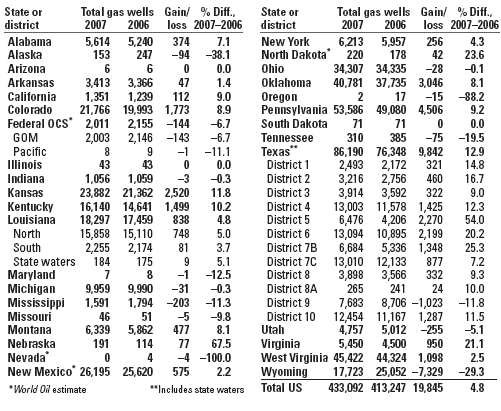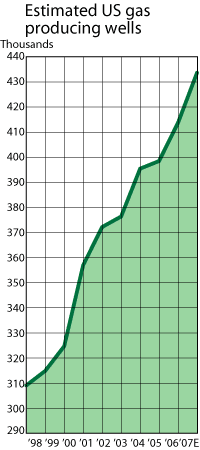For 2007, the number of gas-producing wells rose a solid 4.8% to 19,845 wells. The largest gains came in seven states: Texas (9,842), Pennsylvania (4,506), Oklahoma (3,046), Kansas (2,520), Colorado (1,773), Kentucky (1,499) and West Virginia (1,098). These states represent almost 60% of the new producing gas wells. The rise in the producing gas well totals is due to heavy development drilling in continuous resource shale plays and coalbed methane plays.
Texas maintained its No. 1 spot in total gas producers at more than 86,000 wells. All RRC districts showed gains except for District 9, which dropped almost 12%, more than 1,000 wells. District 6 led in total gas wells at 13,094 followed closely by District 4 with 13,003 wells. The largest new-well increase was in District 5 at 2,270 wells. These gains are all related to the Barnett Shale play, which continues to add new wells at a high rate.
Pennsylvania enjoys second place with its 9.2% gain. This is due to increased drilling in the Marcellus Shale gas play. Many existing holes are being re-entered and drilled laterally to release gas from the fractured shale reservoir.
West Virginia holds third place this year with more than 45,000 wells. The state is exploiting its well-known coal seams for natural gas with many shallow wells.
Oklahoma maintained its fourth-place position. It saw an 8.1% increase, adding more than 3,000 wells, which lifted its total count to nearly 41,000. It has shale and CBM plays at either end of the state. Ohio held onto fifth place with more than 34,000 active gas wells. The state experienced a modest drop, losing 28 wells last year. New Mexico continues to drill CBM wells, which helped it maintained sixth place this year.
Kansas moved up to the No. 7 position with an 11.8% gain, representing an addition of 2,500 new gas wells. In eastern Kansas, the state’s Western Interior Coal Region has gas-producing coal seams. Across west-central Kansas and eastern Nebraska, the Niobrara Chalk is another gas producer. Hugoton Field produces low-Btu gas from the Chase Group, Council Grove Group and Admire Group. In central Kansas, the Wabaunsee Group is a gas target.
| Estimated US wells producing gas at the end of 2007 |
 |
|
Colorado rose to eighth place with almost 22,000 producing wells. Coalbed methane wells in the eastern part of the state are the main objective. Louisiana rose to ninth position with a near-5% gain across the state. Gas activity was focused in the northern region. Wyoming dropped to tenth position this year as CBM activity has slowed. Water disposal problems are limiting operators’ activity and will continue to be a problem until regional solutions are developed.
As the industry gains experience with the existing shale and CBM plays, it is already looking ahead to several new zones as future gas reservoirs. We should see continued growth in gas production in future years from these plays.
The most prolific gas-producing area of the US, the Gulf of Mexico, lost another 6.7% percent of its producing wells over the past year. 
|




